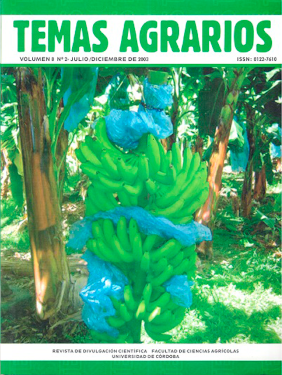Preliiminary study of floral biology of coconut-palm (Cocos nucífera L.) cv. alto Caribe Verde
Estudio preliminar de la biología del cocotero (Cocos nucífera L.) var. alto caribe verde

This work is licensed under a Creative Commons Attribution-NonCommercial 4.0 International License.
Show authors biography
Coconut it is one of the most cultivated palms in the world and is a source of plant oil, food, drink and coverage. The main coconut exporting product is the unprocessed solid endosperm followed by the dried one. Due to diversity and potentiality, coconut is an important component of the economy of producing countries. As a result of its importance for peasants and lack of improved varieties, the present research was done in the ranch “La Milena” located in the “Ciénaga de Oro” municipality, in the Córdoba Department. Ecologically the climate corresponds to tropical dry forest. The study focused on the floral biology of the variety Alto Caribe Verde; the variables evaluated were flowering habit, time to male and female flowering and growth and development, leaf growth, time to spathe emition and flower abortion. The results showed that the variety produces between 14-18 floral spathe a year, the time for female flowering was 4 to 9 days and the time to male flowering was 11 to 26 days. There was a high variability among individuals with respect to number of female flowers per spathe and number of female flowers per spikelet.
Article visits 3149 | PDF visits
Downloads
- Bastidas, H. 1999. Producción de plantas híbridas naturales de cococtero. Corpoica, p.20
- FAOSTAT. 2004. . [Accedido 20 diciembre de 2004].
- Fremond, Y.; Ziller, R. y De Nuce de Lamothe, M. 1969. El cocotero. Editorial Blume. Barcelona 6
- Grange, R. 1993. Crecimiento del fruto. En: Azcon-Bieto, J. y Talón, M. (Ed). Fisiología y Bioquímica Vegetal. Interamericana Mc Graw-Hill, Madrid, p.449-461.
- Hurtado, J. 1998. El cultivo de cocotero. Universidad de Córdoba, Montería, p.60
- IPGRI. 2004. Botany of the coconut palm. . [Accedido 20 diciembre de 2004].
- León, J. 1979. Datos Botánicos. Temas de Orientación Agropecuaria (TOA). Bogotá, 142:14-25.
- Muñoz, M. 2002. Biología floral y fisiología reproductiva en varias accesiones de pronto alivio: Lippia alba Mill. N. E. Brown. Universidad Nacional de Palmira, p.44
- Ohler, J. 1986. El Cocotero, Arbol de Vida. Producción y Protección Vegetal. Roma, Vol 57
- Rognon, F. y De Nuce De Lamothe, M. 1978. Harvesting, conditioning of pollen for the pollination of coconut seed gardens. Oleagineux 33(1):7-23




















